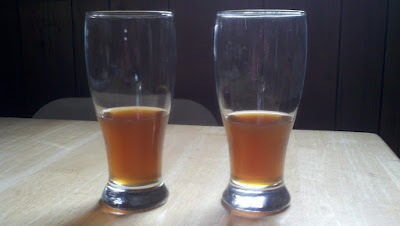Tonight I'm drinking my Autumn Dream Cider... Overall I'm giving it a B-, I'm a little disappointed and I had high hopes for this batch. It tastes good, but I think it's a little too acidic. I can only drink one or two without feeling like I need to take a few TUMS... and it seems to be getting worse as it ages. The only real change I made to the recipe from last year, is that I threw in a few more handfuls of dried cranberries than previously and I think that is the problem. Now I know... Also, this batch does not seem to be clearing at all... I have some finings (additive to help clear beer, wine, cider, etc...) that I didn't end up using and I wish I had tried them. I still have them and will probably try them on my next cider batch.
Also, I have had my Pumpkin Ales sitting in fermentors for almost 5 weeks. Normally I am rushing things and doing things too soon, but I just have not had the energy lately. In this case, the extra time fermenting will only make things better. Anyway, between small home improvement projects today, I managed to gravity test these two and get them into kegs.
So, if you recall, I used two different yeasts on this 10 gallon batch. Yeast is the only difference here so this is kind of a learning experience. Like the Sam Adams Latitude 48 Deconstructed 12 pack, I can compare the difference a single ingredient can make. After starting with the same 1.079 original gravity wort, the different yeasts produced very different results...
The gravity samples...Wyeast 3522 Belgian Ardennes yeast on the left, Fermentis S-04 on the right. They look the same in this pic... (nice color huh?) but IRL, the S-04 cleared quite a bit more than the Ardennes.
The smells are also different... the S-04 smells mainly of pumpkin and malt pretty good... not much spice but nice. The Ardennes though... smells AMAZING! pumpkin, malt, and just the right amount of that Belgian funk...
Also, also... The S-04 fermented from 1.079 down to 1.014. That is exactly what I was shooting for, and that makes the ABV 8.5%, right on target... But, the Ardennes started with the same exact wort and took it down to 1.010! A little drier, maybe thinner body, and 9.0% alcohol! That's a big badass Belgian!
After tasting both, I decided to go ahead and add more pumpkin pie spice to both as I kegged them. While I think the Belgian might have been interesting enough without the extra spice I wanted to keep the yeast the only variable for comparison so I did spice both.
But there is going to be one other difference. See I only have room to force carbonate (the way I usually do it) one of these kegs in my kegerator right now... but there is another way to carbonate. As you would in bottling, once the yeast has consumed all the sugar it can in the beer (which, after 5 weeks, it has) you add a measured amount of sugar and put the beer in a sealed vessel (bottles or keg) The suspended yeast wakes up, fermentation starts up again producing CO2. Because it is in a sealed vessel, the CO2 has nowhere to go except into suspension, carbonating the beer. I decided to force carb the S-04 keg to have on tap first and keg condition (carbonate with sugar) the Belgian outside the kegerator while I am drinking the normal one.
To add the spice to the regular pumpkin ale, all I did was boil 2 cups of water and add 2 tablespoons of pumpkin pie spice. I boiled this for 5 minutes and added to the clean, sanitized, empty keg. Then I racked (siphoned) the beer into the keg, purged the headspace with CO2 from my CO2 tank and regulator. I sealed it up with 30 psi and put in the kegerator to chill. I'll leave it 30 psi for 24 hours and then reduce to serving pressure (12psi) and it will be ready to drink in about a week.
For the Belgian Ardennes I added 3/4 cup (if bottling it would be more like 1 1/4 cups) DME (dry malt extract) to the spice/water mixture and boiled for 10 minutes. I used DME as the sugar for priming (carbonating) but you could use corn sugar too... I don't bother cooling it after boiling, 2 cups of boiling water won't bring the temp of 5 gallons up far enough to hurt the yeast. Again, added this mixture to clean, sanitized, empty keg, siphoned in beer, purge headspace, and seal up with 30psi. But this one I leave out at room temperature so the yeast can do their thing... should take 2-3 weeks but then I'll be able to tap and pour right away after chilling.
So... that's it for tonight I guess. Well, I am planning next beer. Thinking a porter, maybe play with different yeasts or maybe vanilla in half... we'll see... I do want to brew again soon, now that I am brewing double batches, it would be nice to get ahead instead of living brewday to brewday... know what I mean?
Later..




